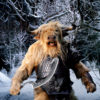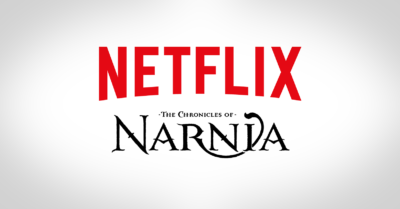USA Today Talks Narnia
The wonderful world of ‘Narnia’
By Susan Wloszczyna, USA TODAY
The majestic lion doesn’t pal around with wacky sidekicks.
The haughty White Witch doesn’t cast a spell on a princess.
And the stately wardrobe, with a secret passageway that leads into an enchanted kingdom, doesn’t break into a jaunty chorus of Be Our Guest.
When the first trailer for The Chronicles of Narnia: The Lion, the Witch and the Wardrobe makes its U.S. premiere Saturday night during ABC’s showing of Harry Potter and the Chamber of Secrets— airing at the same time in 30-plus countries — viewers are apt to gaze in wonder. And be taken aback.
The TV audience may feel as disoriented as the tale’s four young siblings — curious Lucy, disgruntled Edmund, smart Susan and sensible Peter — after they enter the wooden closet and suddenly stumble into Narnia, a frozen paradise terrorized by a power-mad sorceress. Before their eyes, the snow-globe fantasy land of the most popular book in C.S. Lewis’ treasured literary collection comes to swirling life with mythic beasts, snarling wolves and white vistas punctuated by a thunderous roar.
No cutesy creatures. No anachronistic wisecracks. What rushes by is like flipping through a picture book full of rich images. Those who catch the preview of the epic adventure due out Dec. 9, either on TV or when a longer version is attached to the May 19 arrival of the Star Wars finale Revenge of the Sith, may ask themselves, “Can this be Disney?”
Yes, says Dick Cook, the studio chairman and 34-year Disney veteran, about the PG-rated co-production with Walden Media (Holes, Because of Winn-Dixie) whose cost has been estimated as high as $150 million. “This is, without question, one of the most ambitious projects we have been a part of,” he says. “Our desire is to raise our level of storytelling and filmmaking.”
The same Disney that wouldn’t foot the bill for its Miramax label to do three films based on J.R.R. Tolkien’s Lord of the Rings trilogy (New Line Cinema did it, instead) is hoping to launch a seven-part franchise culled from the vivid writings of one of Tolkien’s colleagues. As a result, Wardrobe is a lavish spectacle that aims to reach heights of sophistication and scope that haven’t been seen in non-animated Disney family films since Mary Poppins floated onto the big screen in 1964.
“This is mature family entertainment,” says Narnia producer Mark Johnson, who has overseen such films as The Alamo and The Notebook. He and director Andrew Adamson, responsible for much of the wit and heart found in the Shrek computer-animated comedies, insisted that the digitally rendered animals would push the limits of photo-realism. As Johnson says, “It would be a big mistake if the creatures appear to be cuddly stuffed animals on a little girl’s bed.”
Just as The Little Mermaid rescued Disney animation from going off the deep end in 1989, Narnia aspires to restore the studio’s legacy as the leading maker of all-ages, live-action escapism. And in the nick of time. With its house-brand animation in decline and its partnership with Pixar (The Incredibles) in disrepair, Disney’s family entertainment crown has lost its luster.
Meanwhile, DreamWorks (Shrek 1 and 2, Shark Tale) and 20th Century Fox (Ice Age, Robots) have happily taken up the ‘toon slack. And studios such as Warner Bros. (the Harry Potter series, The Polar Express), Paramount (Lemony Snicket’s A Series of Unfortunate Events) and Universal (How the Grinch Stole Christmas, The Cat in the Hat) continue to push the dark-and-edgy envelope of family fun.
“Disney used to be the only game in town,” says Paul Dergarabedian of box-office tracker Exhibitor Relations. “They were the gold standard of family films, but the rest of the world has gotten more competitive. A big prestige picture could boost the entire studio.”
Narnia, which has sold 85 million copies in 29 languages since Wardrobe was published in 1950, carries a built-in core audience that crosses generations, much like The Lord of the Rings. But fervid fans tend to be sticklers. One sign of Disney’s commitment: the casting of such semi-famous but skillful actors as Tilda Swinton as the Witch. The Scottish actress known for her androgynous looks and offbeat screen roles (Constantine, The Deep End) is about as far as you can get from the music-hall warmth of Julie Andrews.
“I’ve never made a children’s film,” says Swinton, 44, about personifying the most famous wicked witch in literature since The Wizard of Oz. “I’ve never made a film my children can see. I’m not even sure if they’re going to see this one. I don’t want them backing away from me for the rest of my life.”
Disney has been tight-lipped about specific Narnia details, save for the controlled release of general information that appears on the film’s primary independent online site, narniaweb.com.
Instead, early press has been content to focus on what is being painted as a huge marketing test for the studio. That’s because Narnia is no mere bedtime fable.
Lewis invested his adventures with more than such whimsical beings as Mr. Tumnus, a gentle faun forced to do the Witch’s bidding, and Mr. and Mrs. Beaver, talking animals that aid the children in their quest.
The tales also are infused with Christian allegory, and the heroic Aslan is meant as a Christ figure, a redeemer who resurrects in triumph. The challenge: to attract the spiritual-minded moviegoer without turning off the secular crowd.
Disney, along with other studios, has often courted the so-called faith community when the appropriate movie comes along, including such religious-themed comedies as Sister Act or uplifting sports dramas like The Rookie. But since the advent of box-office sensation The Passion of the Christ, such wooing has become a science. For that reason, Disney and Walden have hired Motive Marketing, the company that oversaw The Passion’s outreach program, to assist them.
“It is natural that the press will manufacture more importance about the religious significance than is our intent,” says Dennis Rice, the studio’s vice president of publicity. “We are not going to reach out to one group over the expense of another, but embrace and acknowledge the fans of a very important piece of literature.”
Yes, the filmmakers hosted representatives of more than 30 faith-based and educational groups at a preview held at Disney’s Burbank, Calif., headquarters earlier this year. But, Rice says, “we’re also at Comic-Con in July,” referring to the annual San Diego fantasy, sci-fi and comic-book convention.
Mixing commerce and religion could be risky. But David Koenig, author of Mouse Under Glass: Secrets of Disney Animation and Theme Parks,suggests otherwise. “Left Behind would have been risky,” he says, referring to the evangelical sci-fi book series. “Narnia isn’t risky. It’s the safest way for Disney to reconnect with a large section of its core audience that it has alienated over the last decade.” That includes religious boycotts over gay-friendly policies at theme parks, as well as the often-controversial content of Miramax films.
Faithfulness to the source will likely be of higher importance than faith itself. That is where Adamson comes in. Much as director and fellow New Zealander Peter Jackson used his own love of Tolkien as a guide to bring the Rings trilogy to the screen, Adamson, 38, is relying on the good-vs.-evil battle that unfolded in his imagination as he read the books as an 8-year-old.
“You ultimately can only make something that appeals to your own sensibilities,” says Auckland-born Adamson, whose parents were both associate missionaries in Papua New Guinea. “I am not making religion an issue one way or another. It’s a story about family. People should take from it what they want to take from it.”
Douglas Gresham, Lewis’ stepson who controls the estate and is a co-producer on the film, has wanted to make a movie of Narnia for decades. Lack of the technological tools relegated adaptations to TV versions up until now.
Still, Lewis himself had a love-hate relationship with Hollywood, says Terry Lindvall, who will teach a Christian theology and film course at the College of William & Mary this fall and is author of Surprised by Laughter: The Comic World of C.S. Lewis. “He believed there was death in the camera. Meaning, when you translate word to image, the imagination dies.”
But if anyone could do justice to Lewis’ words, Lindvall believes the man who injected such hilarity into a sour green ogre is the chosen one. “Adamson is the perfect director for this. Lewis was never as somber as Tolkien. He was playful.”
Besides, Lewis believed in translating faith into the vernacular. And, as Lindvall puts it, “The vernacular of our age is movies.”
SIDEBAR: ‘Narnia’ nearly ready
Aslan the lion has lost his voice.
Scottish actor Brian Cox was
to speak for the mane attraction
in Disney’s Chronicles of
Narnia: The Lion, the Witch and
the Wardrobe.
Those who know his work (The
Bourne Supremacy, X-2) might
think — as director Andrew
Adamson did — that his commanding
presence would translate vocally.
But it wasn’t a match made in heaven.
“I love Brian,” Adamson says,
“but we made a mistake. It has to
do with the size of the lion and
finding the right voice quality.”
The search is on
for a new Aslan. But the
other casting pieces, including
four young British newcomers,
are in place.
— Susan Wloszczyna
This story was originally published at USA Today












